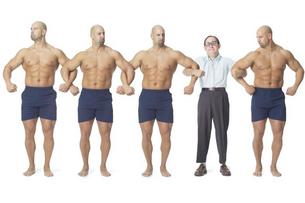Geeks Nerds and Gamers vs. Athletes
Written by
Sophie Lizard
Even in the beginning, there was battle.
Humankind has evolved through millennia of struggle and intense teamwork to survive. Over time, most cultures devised games to develop and celebrate these principles of strategic exertion and co-operation, from the famous Mayan ball games to high school football teams and Grifball for Halo gamers.
From almost the moment of the Internet’s birth, geeks, nerds and gamers made it their playground. The first multi-user dungeon, a virtual world created for multiplayer online gaming, was developed in 1978 and connected to the Net in 1980. After that, role playing geeks shifted gradually from basements filled with hand-drawn maps and many-sided dice into the boundless potential of cyberspace.
Live Battling and Online Role Playing Games
Massively multiplayer online role play gaming (MMORPG) and live action role playing (LARP) have run as parallel tracks in geek and gaming subculture for the last few decades. Both focus on character development in a fictional universe, with conflict typically an unavoidable element even in non-battle games.
MMORPGs are big business: World of Warcraft exceeded 10 million subscribers by the end of 2011, and Star Wars: The Old Republic found its first million users within mere days of its launch around the same time. LARP settings like World of Darkness and live action battle games like Dagorhir have smaller audiences, but are increasing in popularity as streaming video and social media make their organization and promotion easier.
Many larpers and battle gamers first realize their love of larping in childhood, creating complex and highly detailed imaginary games with friends. After that, word of mouth through family and friends is the greatest factor in adding new larpers to the fold, with TV and Internet exposure as secondary routes for LARP community recruitment. Weekends and holidays become potential LARP dates as the novice grows into a committed player.
Both MMORPG and LARP give players the opportunity to explore different identities, roles and emotional ranges appealing to men, women and children of all sizes and fitness levels. Some larpers, particularly in Nordic LARP communities, also bring political commentary and avant-garde self-expression to the game. It’s continually evolving.
As Aaron Vanek, author of Cooler Than You Think: Understanding Live Action Role Playing (LARP), puts it, “I hope that beginners to this amazing endeavor will be intrigued enough to try one, and veterans will be inspired to create, improve, and market their own games on a broader stage.”
Live Action Athletes
The more athletic forms of larping are team live action battles played with soft boffer weapons or harmless replicas. A typical player in a LARP-influenced battle game is under 40 years old, educated, creative and motivated by a desire for fun and kinship, with fitness more a side effect of battle than a primary benefit. Couples and families often participate together in live action events, strengthening the sense of genuine community felt by the players.
Battle gamers may be athletic, but it isn’t a prerequisite. In Polearmball, physical and tactical skills are held in perfect balance.
Who has what it takes to handle physical challenges like those of a Tough Mudder obstacle course and the weapon-brandishing excitement of battle gaming or LARP battles? The geeks, nerds and gamers. Anything they lack in raw physical prowess is compensated by courage, determination and smart tactical thinking.
A gamer experienced in the battlefield tactics and protocols of online war games is already well prepared for the mental challenges of a live battle game. Instead of relying purely on athleticism, Polearmball draws on the geek and gamer heritage of strategic decision-making to create a physical game in which nerds can excel just as much as athletes.
Most people who enjoy larping or online gaming will also enjoy live battle games – all the imaginative storytelling elements are there, but with a healthy dose of physical exercise and mental focus to make the game more exciting. Points may be awarded for bravery, acting performance, physical achievement, personal sacrifice and other criteria according to the rule book of the game, so each player works with their strengths and improves their weaknesses.
Women in Live Action Battle Games
LARP and live action battle aren’t as male-dominated as many outsiders expect. Many women enjoy video gaming, larping and battle gaming; half of all online gamers are now female, in contrast to the much lower proportion of female players in the early years of online gaming.
Geeky women and girls may be attracted by larping’s uniqueness and fantasy roots, making them more likely than men to accept an invitation to LARP. Female athletes who discover battle games are often pleased with the social and creative aspects of the game in comparison to sports like soccer or baseball.
Female players report little or no sexism in live action games. Gender is flexible in many games; more than half of all MMORPG and LARP players have taken on a character of the opposite sex within the game.
Like the traditional martial arts, live action battle games offer mental and physical health benefits for players, including stress relief and companionship, which keep female and male players coming back for more.
BIO:
Sophie Lizard
is a freelance writer fascinated by culture and technology. Visit http://BeAFreelanceBlogger.com to build your own freelance writing career online, or find out more about Sophie's work at http://LizardCreativeChaos.com



